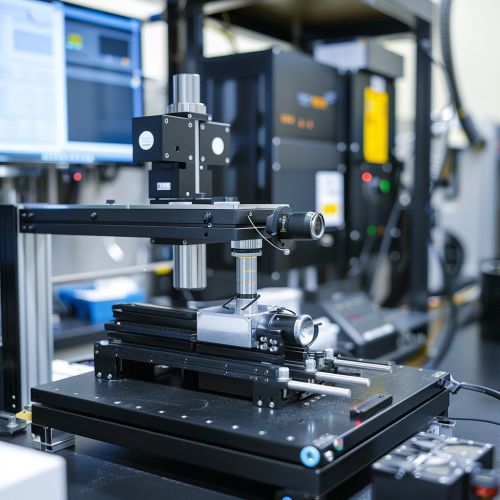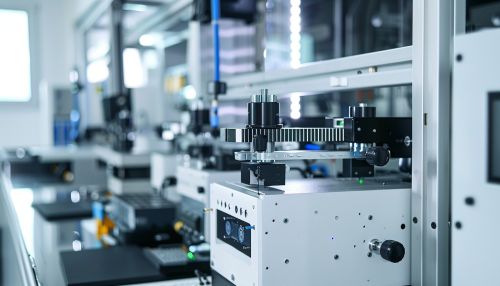Solid-state laser
Introduction
A solid-state laser is a laser that uses a solid gain medium, as opposed to a liquid or gas medium. The gain medium is typically a crystal or glass doped with rare-earth or transition-metal ions. These lasers are widely used in various applications, including material processing, medical procedures, and scientific research. The development of solid-state lasers has significantly advanced the field of photonics, providing powerful and efficient sources of coherent light.
History and Development
The concept of the solid-state laser was first proposed by Arthur Schawlow and Charles Townes in 1958. The first successful demonstration of a solid-state laser was achieved by Theodore Maiman in 1960 using a ruby crystal as the gain medium. This breakthrough marked the beginning of a new era in laser technology. Subsequent developments have led to the creation of various types of solid-state lasers, each with unique properties and applications.
Types of Solid-State Lasers
Ruby Laser
The ruby laser was the first type of solid-state laser to be developed. It uses a synthetic ruby crystal (aluminum oxide doped with chromium ions) as the gain medium. The ruby laser operates at a wavelength of 694.3 nm, producing red light. Although it is not widely used today due to its low efficiency and high threshold, the ruby laser played a crucial role in the early development of laser technology.
Nd:YAG Laser
The Nd:YAG laser (neodymium-doped yttrium aluminum garnet) is one of the most commonly used solid-state lasers. It operates at a wavelength of 1064 nm in the infrared region. Nd:YAG lasers are known for their high efficiency, excellent beam quality, and versatility. They are used in various applications, including laser cutting, laser welding, and medical laser procedures.
Ti:Sapphire Laser
The Ti:sapphire laser (titanium-doped sapphire) is a tunable solid-state laser that can operate over a broad range of wavelengths, typically from 650 nm to 1100 nm. It is widely used in scientific research, particularly in ultrafast spectroscopy and femtosecond pulse generation. The Ti:sapphire laser's ability to produce extremely short pulses makes it an invaluable tool in studying fast dynamic processes.
Er:YAG Laser
The Er:YAG laser (erbium-doped yttrium aluminum garnet) operates at a wavelength of 2940 nm in the mid-infrared region. It is highly absorbed by water and biological tissues, making it ideal for medical applications such as laser dentistry and dermatology. The Er:YAG laser's precise cutting ability and minimal thermal damage make it a preferred choice for delicate surgical procedures.


Operating Principles
Solid-state lasers operate based on the principle of stimulated emission. The gain medium, typically a crystal or glass doped with rare-earth or transition-metal ions, is pumped with energy from an external source, such as a flashlamp or a diode laser. This pumping process excites the electrons in the dopant ions to higher energy levels. When these electrons return to their lower energy states, they emit photons, which stimulate the emission of more photons, leading to the amplification of light.
Pumping Mechanisms
There are several methods for pumping solid-state lasers, including optical pumping and electrical pumping. Optical pumping is the most common method and involves using a light source, such as a flashlamp or a diode laser, to excite the gain medium. Electrical pumping, although less common, involves using an electric current to excite the gain medium.
Laser Cavity
The laser cavity, or resonator, is an essential component of a solid-state laser. It consists of two mirrors placed at either end of the gain medium. One mirror is highly reflective, while the other is partially reflective, allowing a portion of the light to exit the cavity as the laser beam. The laser cavity enhances the amplification process by reflecting the photons back and forth through the gain medium, increasing the likelihood of stimulated emission.
Applications
Solid-state lasers have a wide range of applications across various fields due to their versatility, efficiency, and high beam quality.
Material Processing
Solid-state lasers are extensively used in material processing applications such as laser cutting, laser welding, and laser engraving. Their ability to deliver high power and precise control makes them ideal for cutting and welding metals, ceramics, and other materials. Solid-state lasers are also used in additive manufacturing processes, such as selective laser sintering and laser cladding.
Medical Applications
In the medical field, solid-state lasers are used for various diagnostic and therapeutic procedures. They are employed in laser surgery, ophthalmology, dermatology, and dentistry. For example, Nd:YAG lasers are used in laser eye surgery to correct vision problems, while Er:YAG lasers are used in laser skin resurfacing to treat wrinkles and scars.
Scientific Research
Solid-state lasers are indispensable tools in scientific research. They are used in spectroscopy, laser-induced fluorescence, Raman spectroscopy, and nonlinear optics. The ability of solid-state lasers to produce ultrafast pulses has revolutionized the study of dynamic processes at the molecular and atomic levels. Ti:sapphire lasers, in particular, are widely used in femtosecond laser spectroscopy to investigate ultrafast chemical reactions and biological processes.
Communication and Information Technology
Solid-state lasers play a crucial role in optical communication systems, where they are used as light sources for transmitting data over optical fibers. They are also used in data storage devices, such as optical discs and laser printers. The development of high-power solid-state lasers has enabled advancements in free-space optical communication and LiDAR (Light Detection and Ranging) technology.
Advantages and Disadvantages
Advantages
Solid-state lasers offer several advantages over other types of lasers:
- **High Efficiency**: Solid-state lasers have high conversion efficiency, meaning they can convert a significant portion of the input energy into laser light.
- **Good Beam Quality**: They produce high-quality beams with low divergence and high coherence.
- **Versatility**: Solid-state lasers can be designed to operate at various wavelengths and pulse durations, making them suitable for a wide range of applications.
- **Compact and Robust**: Solid-state lasers are generally more compact and robust than gas or liquid lasers, making them easier to integrate into various systems.
Disadvantages
Despite their advantages, solid-state lasers also have some limitations:
- **Thermal Management**: Solid-state lasers generate heat during operation, which can affect their performance and lifespan. Effective thermal management is essential to maintain stable operation.
- **Complexity and Cost**: The design and fabrication of solid-state lasers can be complex and expensive, particularly for high-power and ultrafast systems.
- **Limited Wavelength Range**: While solid-state lasers can operate at various wavelengths, they are generally limited to specific regions of the electromagnetic spectrum, depending on the gain medium used.
Future Trends
The field of solid-state lasers continues to evolve, with ongoing research and development focused on improving their performance and expanding their applications. Some of the key trends and advancements include:
- **High-Power Lasers**: Development of high-power solid-state lasers for industrial and defense applications, including directed energy weapons and large-scale material processing.
- **Ultrafast Lasers**: Advances in ultrafast laser technology, enabling the generation of shorter pulses with higher peak powers for applications in scientific research and medical procedures.
- **Tunable Lasers**: Development of tunable solid-state lasers that can operate over a broader range of wavelengths, providing greater flexibility for various applications.
- **Compact and Portable Systems**: Miniaturization of solid-state lasers to create compact and portable systems for field applications, such as handheld diagnostic devices and portable communication systems.
